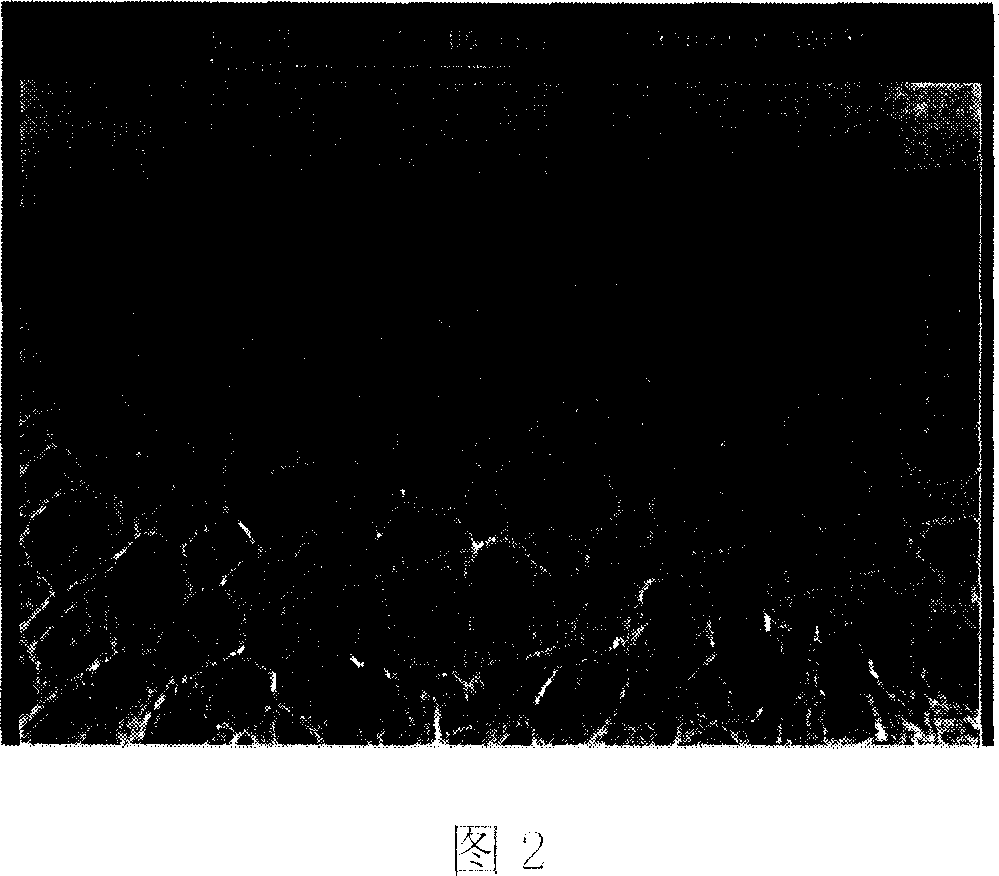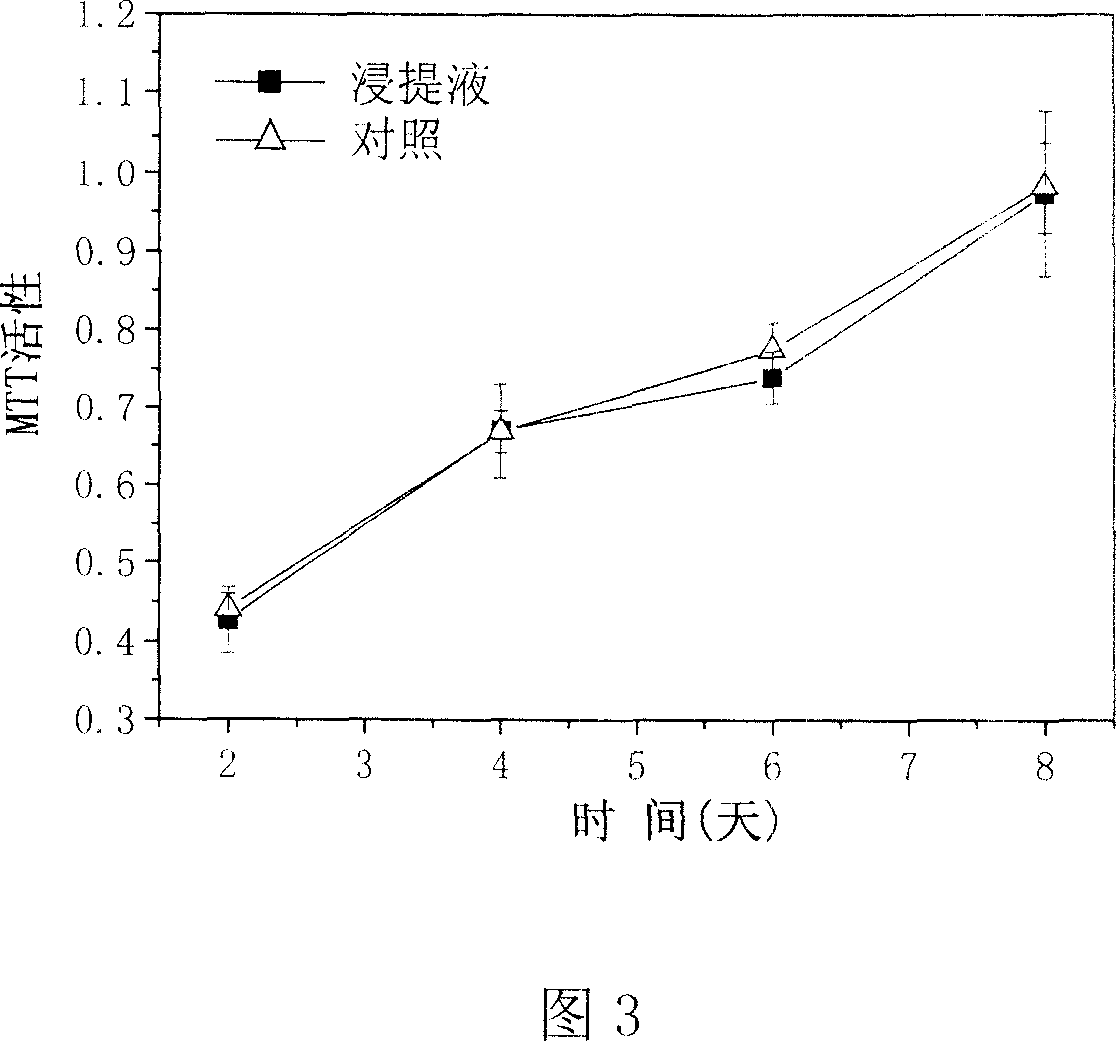Collagen-chitin and silicon rubber bilayer skin regeneration support and its preparation method
A technology of skin regeneration and chitosan, applied in medical science, prosthesis, etc., can solve the problem of insufficient supply of autologous skin, achieve the effect of promoting coagulation wound healing, improving mechanical strength, and good tissue compatibility
- Summary
- Abstract
- Description
- Claims
- Application Information
AI Technical Summary
Problems solved by technology
Method used
Image
Examples
Embodiment 1
[0026] Collagen and chitosan were dissolved in 3% acetic acid solution respectively, and the preparation concentration was 0.5% collagen solution and 0.5% chitosan solution, and the chitosan solution was dropped into the collagen solution, wherein the chitosan The content is 10%, stir evenly and vacuum degassing; use freeze-lyophilization method, freeze at -20°C for 2 hours, and then freeze-dry for 24 hours. Freeze-dried collagen / chitosan scaffolds were cross-linked in a vacuum oven at 105°C for 12 hours, cross-linked with 0.25% glutaraldehyde solution at 4°C for 24 hours, rinsed repeatedly with triple distilled water, and then frozen again - freeze-drying to obtain cross-linked collagen-chitosan porous scaffolds. On the surface of a silicone rubber film with a thickness of about 0.14 mm, a gelatin adhesive with good biocompatibility was added at 0.25 mg / cm 2 Evenly coated on the surface of the silicone rubber film, and then the collagen-chitosan porous scaffold was gently pl...
Embodiment 2
[0028] Collagen and chitosan were dissolved in 3% acetic acid solution respectively, and the preparation concentration was 0.5% collagen solution and 0.5% chitosan solution, and the chitosan solution was dropped into the collagen solution, wherein the chitosan The content is 10%, stir evenly and vacuum degassing; use freeze-lyophilization method, freeze at -20°C for 2 hours, and then freeze-dry for 24 hours. Freeze-dried collagen-chitosan scaffolds were cross-linked in a vacuum oven at 105°C for 12 hours, then cross-linked with 0.25% glutaraldehyde solution at 4°C for 24 hours, rinsed repeatedly with three-distilled water, and then frozen again - freeze-drying to obtain cross-linked collagen-chitosan porous scaffolds. On the surface of a silicone rubber film with a thickness of about 0.14 mm, α-cyanoacrylate octyl adhesive with good biocompatibility was added at 0.25 mg / cm 2 Evenly coated the surface of the silicone rubber film, and then gently placed the collagen-chitosan po...
Embodiment 3
[0030]Collagen and chitosan were dissolved in 0.3% acetic acid solution respectively to prepare a 0.5% collagen solution and a 0.5% chitosan solution, and the chitosan solution was dropped into the collagen solution, wherein the chitosan The content is 5%, stir evenly and vacuum degassing; use freeze-lyophilization method, freeze to solid at -5°C, and then freeze-dry for 24 hours. Freeze-dried collagen / chitosan scaffolds were cross-linked in a vacuum oven at 80°C for 12 hours, cross-linked with 0.05% glutaraldehyde solution at 4°C for 1 hour, rinsed repeatedly with triple distilled water, and then frozen again - freeze-drying to obtain cross-linked collagen-chitosan porous scaffolds. On the surface of a silicone rubber film with a thickness of about 0.05 mm, α-cyanoacrylate octyl adhesive with good biocompatibility was added at 0.05 mg / cm 2 Evenly coated the surface of the silicone rubber film, and then gently placed the collagen-chitosan porous scaffold on the surface of the...
PUM
 Login to View More
Login to View More Abstract
Description
Claims
Application Information
 Login to View More
Login to View More - R&D
- Intellectual Property
- Life Sciences
- Materials
- Tech Scout
- Unparalleled Data Quality
- Higher Quality Content
- 60% Fewer Hallucinations
Browse by: Latest US Patents, China's latest patents, Technical Efficacy Thesaurus, Application Domain, Technology Topic, Popular Technical Reports.
© 2025 PatSnap. All rights reserved.Legal|Privacy policy|Modern Slavery Act Transparency Statement|Sitemap|About US| Contact US: help@patsnap.com



